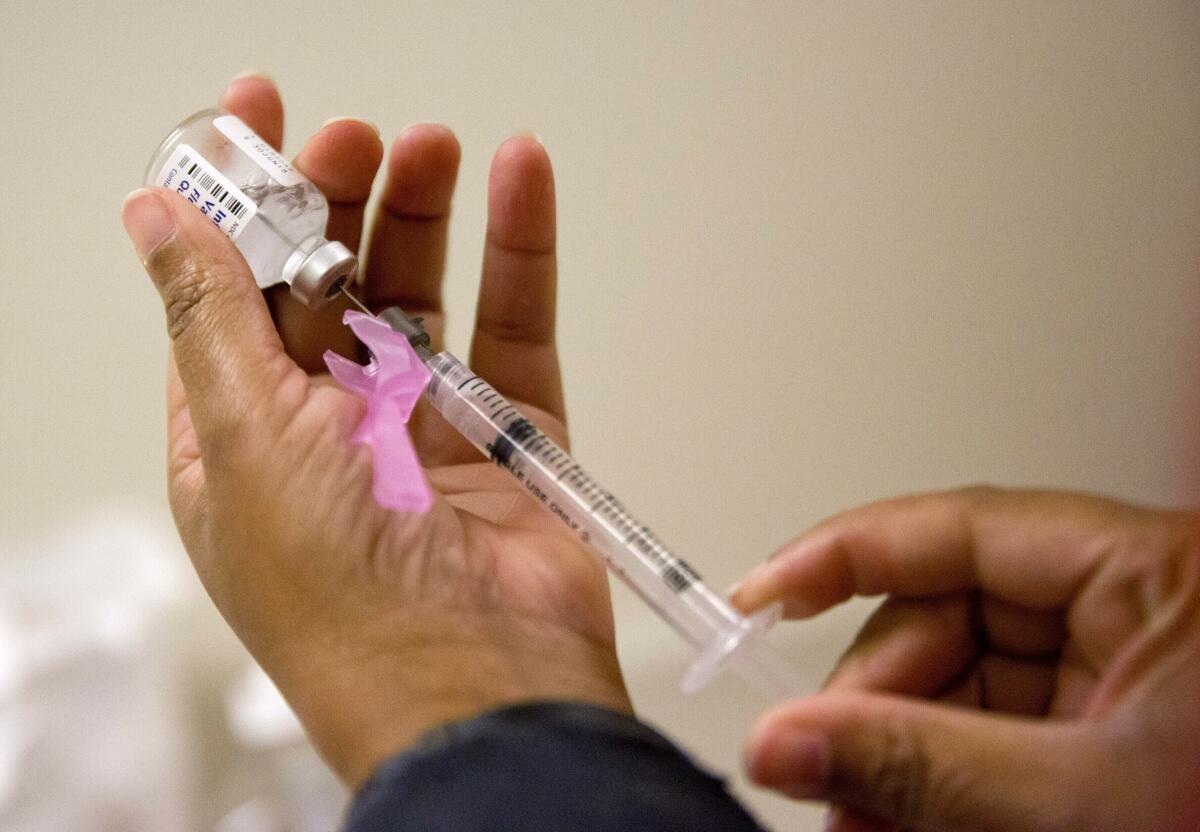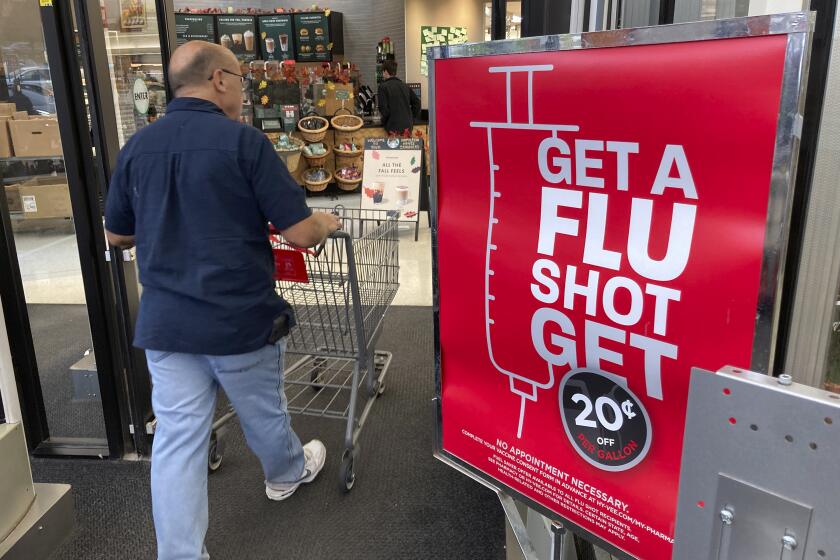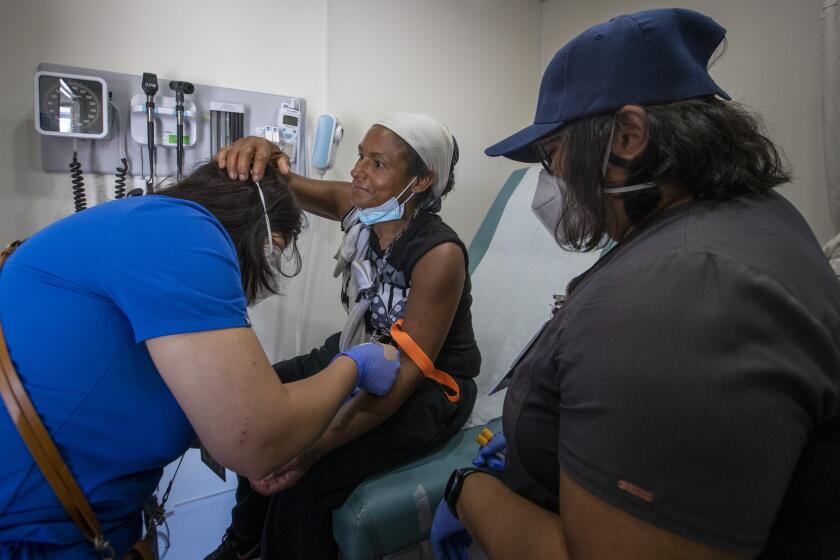Nearly 40% of students absent at San Diego school as wave of illness signals fierce flu season

- Share via
Alarming surges of respiratory illness at a San Diego high school and the region’s only children’s hospital are strong evidence that a fierce flu season has arrived early this year.
About 1,000 of the 2,600 students at Patrick Henry High School in San Carlos were absent Wednesday, with the majority said to have gotten sick in the week after homecoming weekend. Hundreds of them, school officials told parents in a notice, tested negative for COVID-19 , causing public health officials to say they suspect the unprecedented outbreak was caused by the flu. Respiratory syncytial virus, or RSV, could also be playing a role.
Dr. Cameron Kaiser, a deputy public health officer for San Diego County, said his office is monitoring the outbreak due to its sheer size. No school has come close to seeing 40% of its student body call out sick during the COVID-19 pandemic.
The global public health community has warned for months that the U.S. may be in for a particularly severe flu season after serious bouts of influenza-related illness flooded hospitals in Australia during the Southern Hemisphere’s winter season in recent months.
“Seeing this in October is pretty staggering,” Kaiser said. “While the majority of kids are going to be just fine, you know, if we’re seeing flu outbreaks that large at a local high school, we’re probably seeing them in other places in the community.”
Influenza has been largely dormant the past two seasons, possibly due to the infection-prevention protocols put in place to ward off the coronavirus.
Officials said they were looking for similarly large levels of absenteeism at other local schools but had not yet been made aware of other examples.
“I don’t have any reason to believe it’s purely restricted to [Patrick Henry High],” Kaiser said.
Already, the region’s total flu cases this season, which started July 1, is significant with 1,000 cases confirmed so far. The most recent week for which local data are available recorded 304 cases, Kaiser said, compared with a prior five-year average of 22.
And it’s not just the flu that’s spiking.
Rady Children’s Hospital is also experiencing an unexpected increase in the number of kids arriving in its emergency department with runny noses, coughing, sneezing, fever and shortness of breath, officials said Wednesday afternoon.
These children are testing negative for the coronavirus but have for the most part been confirmed to have RSV, said Dr. John Bradley, director of Rady’s Division of Infectious Diseases. The virus is one of several that cause the common cold, though infection can be more severe in some, especially young kids, which has been the case at Rady over the last week.
“Getting both vaccines at the same visit increases the chance that a person will be up to date with their vaccinations,” the CDC says.
Bradley said the hospital has admitted about 250 young children with RSV infections that have caused lower respiratory tract infections that, in some cases, have turned into viral pneumonia, requiring supplemental oxygen treatment.
RSV is highly contagious and is known to cause an increase of sick visits in the winter months, but Bradley said such a fierce and early arrival is very uncommon.
“I’ve been here for 34 years, and I’ve never seen this kind of volume in October,” Bradley said. “This is like something we might see in January in the middle of an influenza epidemic, but not in October.”
About 20% of children in Rady’s intensive care units Wednesday were admitted due to severe breathing problems caused by RSV-related lung inflammation, Bradley said.
Those with more mild breathing problems, he said, receive supplemental oxygen for about two days while those in intensive care tend to have chronic lung disorders or neurologic disorders that require additional “positive pressure” to reopen lung passages.
“All you need to do is give them oxygen and a little bit of pressure to help them expand their lungs and they’re fine,” Bradley said, adding that less than 10% of children with RSV have needed intensive care.
The Department of Health Services launched a system of rolling clinics, expanding the care that clinicians can immediately offer to unhoused people.
As to why RSV has made such an early and fierce run at local children, Bradley said that it may be a more aggressive strain of the virus in circulation this year. But the COVID-19 pandemic, which kept young children home for the first few years of their lives, is also likely playing a significant role.
RSV, he said, is known to be the most common cause of hospitalization for pneumonia in children, and the odds of a severe case are the highest with the first or second infections. After the immune system has had a few chances to fight off the virus, symptoms become more cold-like for the rest of a person’s life.
Kids who spent their first few years of life in COVID-19 precautionary isolation, then, never picked up RSV and are now doing so as they arrive at preschool age.
“If you look at it from a birth cohort standpoint, there are probably two or three times more susceptible children who’ve never had RSV in the community right now,” Bradley said. “When they get infected, they spread this to older siblings, so we’re admitting a lot of infants, but also a lot of older kids with, say, asthma or some other underlying disease.”
More to Read
Sign up for Essential California
The most important California stories and recommendations in your inbox every morning.
You may occasionally receive promotional content from the Los Angeles Times.














